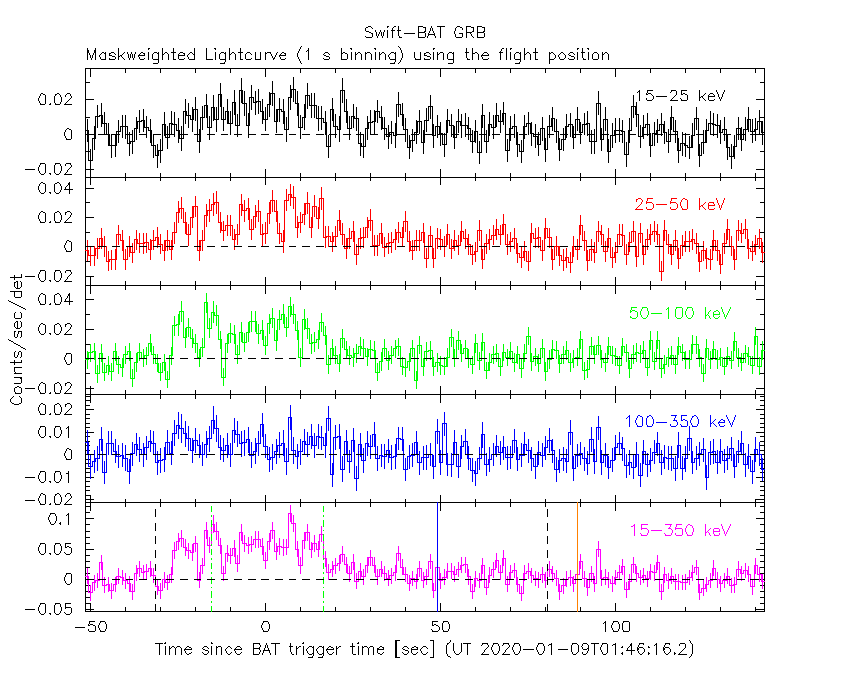
A. Melandri (INAF-OAB), V. D'Elia (ASDC) and K.K. Simpson (PSU) for the Swift team
At 01:46:16 UT, the Swift Burst Alert Telescope (BAT) triggered and located GRB 200109A (trigger=948361) (Melandri et al. GCN Circ. 26678). Swift slewed immediately to the burst. At the time of the trigger, the initial BAT position was 77° from the Sun (1.2 hours East) and 97° from the 96%-illuminated Moon. Table 1 contains the best reported positions from Swift, and the latest XRT position can be viewed at http://www.swift.ac.uk/xrt_positions.
Table 2 is a summary of GCN Circulars about this GRB from observatories other than Swift.
Standard analysis products for this burst are available at https://gcn.gsfc.nasa.gov/swift_gnd_ana.html.
As reported by Krimm et al. (GCN Circ. 26692),
the BAT ground-calculated position is RA, Dec = 307.116, 52.988 deg which is RA(J2000) = 2
The mask-weighted light curve (Figure 1) shows a weak structure with several overlapping pulses that start at ~T-30 s to ~T+20 s, followed by a weaker tail emission that lasts till ~T+100 s.
The time-averaged spectrum from T-31.45 to T+112.55 s is best fit by a simple power-law model.
The power law index of the time-averaged spectrum is 1.31 ± 0.14.
The fluence in the 15-150 keV band is 2.1 ± 0.2 x 1
The results of the batgrbproduct analysis are available at https://gcn.gsfc.nasa.gov/notices_s/948361/BA/.
Analysis of the initial XRT data was reported by D'Elia et al. (GCN Circ. 26682). We have analysed 6.6 ks of XRT data for GRB 200109A, from 91 s to 28.4 ks after the BAT trigger. The data comprise 48 s in Windowed Timing (WT) mode (the first 7 s were taken while Swift was slewing) with the remainder in Photon Counting (PC) mode. The enhanced XRT position for this burst was given by Goad et al. (GCN Circ. 26681).
The light curve (Figure 2) can be modelled with a series of power-law decays. The initial decay index is α=1.9 ± 0.3. At T+216 s the decay steepens to an α of 8.0 (+0.0, -3.2) before breaking again at T+269 s to a final decay with index α=1.31 (+0.21, -0.16).
A spectrum formed from the PC mode data can be fitted with an absorbed power-law with a photon spectral index of 1.67 (+0.32, -0.30). The best-fitting absorption column is 7.2 (+2.9, -2.4) x 1
A summary of the PC-mode spectrum is thus:
Total column: 7.2 (+2.9, -2.4) x 1
Galactic foreground: 4.0 x 1
Excess significance: 2.2 σ
Photon index: 1.67 (+0.32, -0.30)
The results of the XRT team automatic analysis are available at http://www.swift.ac.uk/xrt_products/00948361.
The Swift/UVOT began settled observations of the field of GRB 200109A 110 s after the BAT trigger
(Simpson and Melandri GCN Circ. 26690).
No optical afterglow consistent with the XRT position is detected in the initial UVOT exposures.
Table 3 gives preliminary
magnitudes using the UVOT photometric system
(Breeveld et al. 2011, AIP Conf. Proc., 1358, 373).
No correction has been made for the expected extinction in the Milky Way
corresponding to a reddening of

Figure 1. The BAT
mask-weighted light curve in the four individual and total
energy bands. The units are counts

Figure 2. The XRT light curve.
Any data from a crosshatched region are not included in the fit.
| RA (J2000) | Dec (J2000) | Error | Note | Reference |
|---|---|---|---|---|
| 2 |
+52°59'36.9" | 1.4" | XRT-final | UKSSDC |
| 2 |
+52°59'37.1" | 1.7" | XRT-enhanced | Goad et al. GCN Circ. 26681 |
| 2 |
+52°59'17.7" | 1.2' | BAT-refined | Krimm et al. GCN Circ. 26692 |
| Band | Authors | GCN Circ. | Subject | Observatory | Notes |
|---|---|---|---|---|---|
| Optical | Lipunov et al. | 26679 | Swift GRB200109.07: Global MASTER-Net observations report |
MASTER | |
| Gamma-ray | Fermi | 26677 | Fermi GBM Final Real-time Localization | Fermi GBM | |
| Gamma-ray | Hamburg and Meegan | 26689 | Fermi GBM observation | Fermi GBM | Fluence=6.9±0.6x1 (6 |
| Gamma-ray | Xiao et al. | 26710 | Insight-HXMT/HE detection | Insight-HXMT |
| Filter | Exp(s) | Mag | ||
|---|---|---|---|---|
| whit |
110 | 259 | 147 | >20.5 |
| 268 | 518 | 246 | >19.0 | |
| white | 110 | 1023 | 295 | >20.9 |
| u | 268 | 518 | 246 | >19.0 |
Table 3. UVOT observations reported by Simpson and Melandri (GCN Circ. 26690). The start and stop times of the exposures are given in seconds since the BAT trigger. The preliminary 3-σ upper limits are given. No correction has been made for extinction in the Milky Way.
January 12, 2020